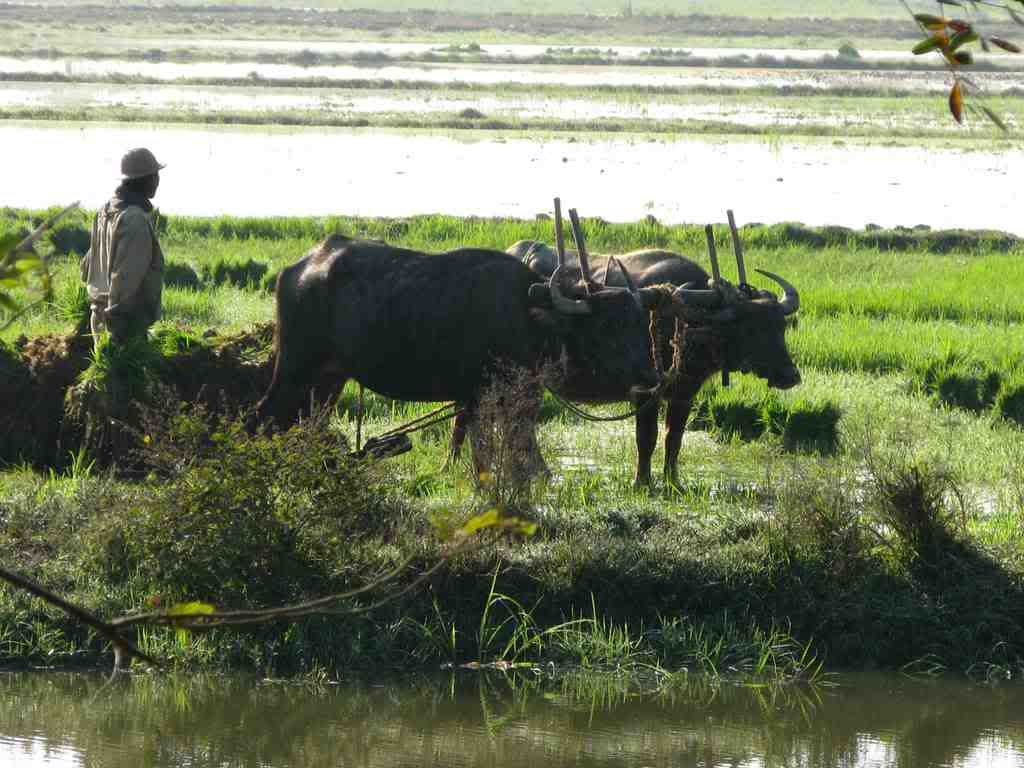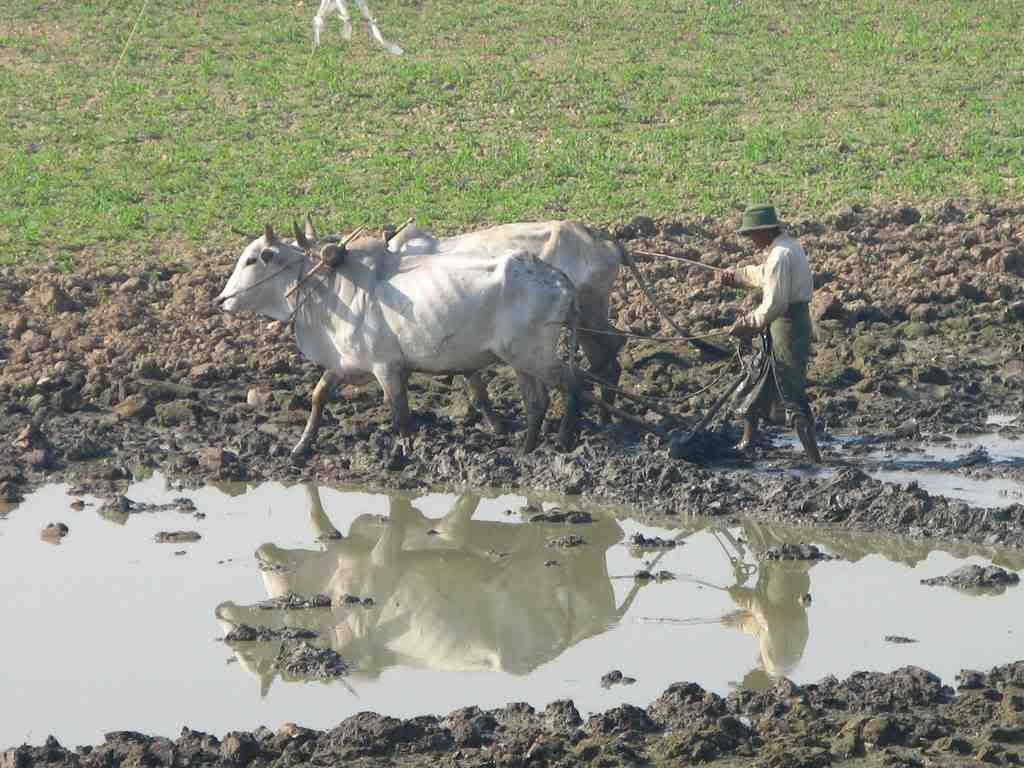The cyclone and its accompanying storm surge devastated the low-lying Ayeyarwaddy Delta, the source of 65% of the country's rice production. The damage caused by the storm, and its impact on the delta's rice paddies, will reverberate through the entire region.
What This Means For Myanmar
Most Myanmar villagers farm the way their grandfathers did – using plows drawn by oxen or water buffaloes, and fertilizing their fields with manure. Nevertheless, the country produces more rice than it needs, and has exported its surplus rice for many years.
A farmer and his water buffaloes plowing a rice paddy somewhere between Yangon and Bago

This rice farmer near Mandalay prefers oxen

Rice paddies are normally flooded during the early part of the crop cycle. But this storm struck the delta during the worst possible time – the winter crop harvest period. Fields like the ones shown above are now completely under water. What hasn't been destroyed by flood waters has been polluted by dead bodies – both human and animal.
The region to the southeast of Yangon received a double-whammy. In addition to damage caused by the cyclone's winds and rain, a 12-foot high storm surge inundated the coastal region with sea water.
Rice farmers in Louisiana learned first-hand in 2005 about the long-term damage a storm surge can bring. The storm surge that accompanied Hurricane Rita contaminated Vermilion Parish's rice fields with sea water. The resulting high salt levels put most of the fields out of commission for a year or more.
Under normal conditions, rice farmers in the Ayeyarwaddy Delta produce two – sometimes even three – crops each year. The country had been planning to expand rice acreage to 8.26 million hectares (20.4 million acres) from 8.1 million hectares (20 million acres) this year – an increase of just under 2%. Instead, the arable acreage in the delta will shrink dramatically.
The International Impact
In 2003, Myanmar produced 27 million tons* (24.6 metric tonnes) of rice. Only Bangladesh, China, India, Indonesia and Vietnam grew more rice that year. Between April 2004 and March 2006, the country exported 180,000 tons of rice annually. Its rice exports fell to just 14,500 tons in fiscal year 2006/07, but rebounded in 2007/08.
Myanmar had been able to take advantage of recent shortages and high prices to expand its sales of rice to Bangladesh (~198,000 tons), Singapore (385 tons) and Sri Lanka (5,500 tons). The country was expected to export 660,000 tons of rice in 2008/09. This will no longer be possible, thanks to Cyclone Nargis.
As recently as May 5th, The Wall Street Journal (WSJ) carried a story with the headline "Softening Rice Prices Suggest Market Peak Has Come, Gone." According to the article by Tom Polansek, Thailand – the world's largest rice exporter – had begun to release into the market 2.1 million tonnes (2.3 million tons) of rice that it had stockpiled.
But this story was out-of-date even before it was published. On May 6th, Bangladesh announced a virtual ban on rice exports. The following day, BBC reported that rice prices had risen for the fourth day in a row at the Chicago Board of Trade.
Myanmar's exports are little more than a drop in the world's rice bucket. The WSJ article mentioned that world rice "ending" stocks (the rice left over after taking supply and demand into account) surpassed 77 million tonnes (85 million tons) in April. Now some of that excess rice will be needed to feed Myanmar's displaced farmers and city dwellers.
The annual rice consumption by Myanmar's people in normal times is approximately 17 million tons, all of which is grown domestically. With the fields that produce 65% of the rice crop unusable, possibly for a year or more, the country may need to import as much as 11 million tons of rice – roughly 13% of the world's surplus – to feed its people.
Inevitably, Myanmar's unanticipated need to import large amounts of rice and other foodstuffs will force the international price of rice even higher than ever. We have already seen riots in Bangladesh, Haiti, Egypt and Somalia, among others, as their people rebelled against food shortages and high prices. Watch for more violence as prices spike even higher and as countries compound the problem by hoarding their surpluses for internal consumption.
Cyclone Nargis made its landfall in Myanmar. But its impact will be felt around the world.
*Please note. For consistency of presentation and for the convenience of readers, I have converted metric tonnes into US tons.





No comments:
Post a Comment
Note: Only a member of this blog may post a comment.